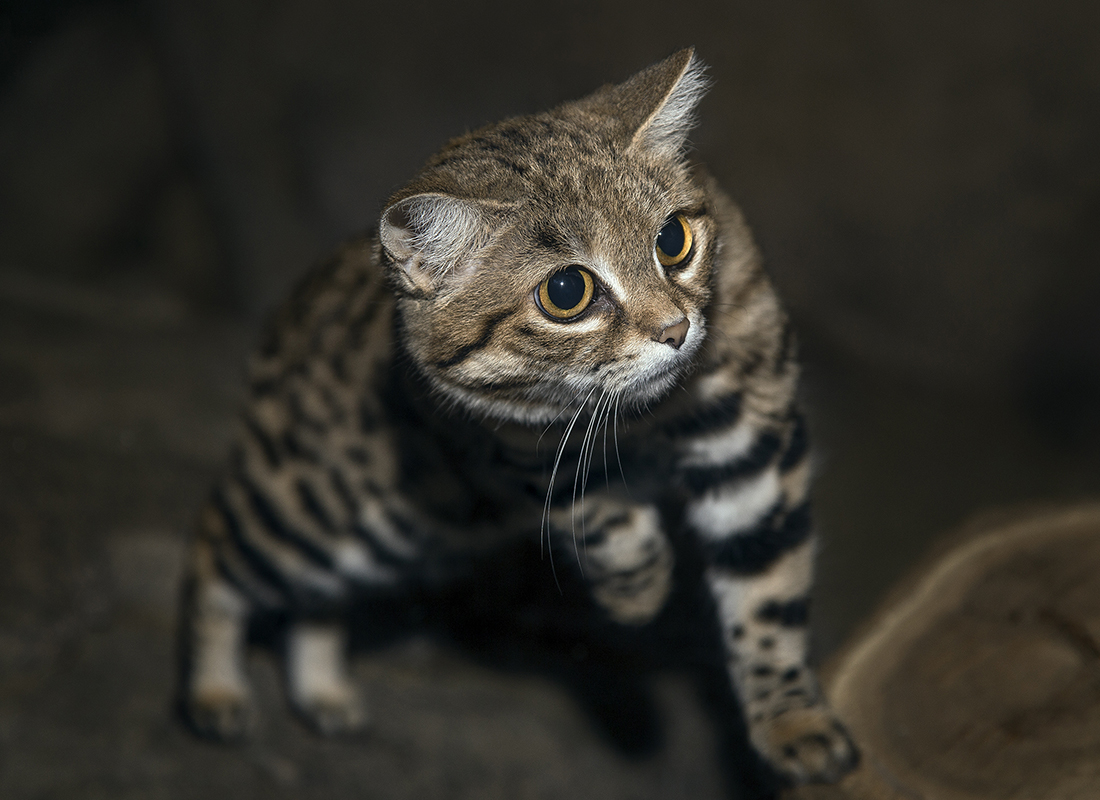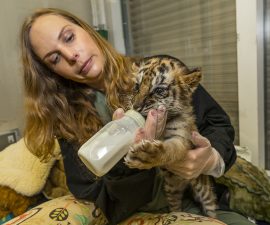BY Peggy Scott
Photography by Tammy Spratt
For a living, breathing, furry example of the adage, “Don’t judge a book by its cover,” one need look no further than the black-footed cat. While at first glance the house-cat-sized Felis nigripes may appear to be a short story, its personality, tenacity, and hunting prowess are epic-worthy. “They are big cats in a small cat package,” says Autumn Nelson, animal care supervisor of mammals at the San Diego Zoo Safari Park, whose duties include overseeing care of two of the Park’s black-footed cats, Yuna and Sawyer. She is also a member of the Black-footed Cat Species Survival Plan (SSP) Management Group. “They are tough little guys!” A very busy guy, Sawyer divides his time between the Safari Park and his accommodations at the off-ground cheetah breeding center.
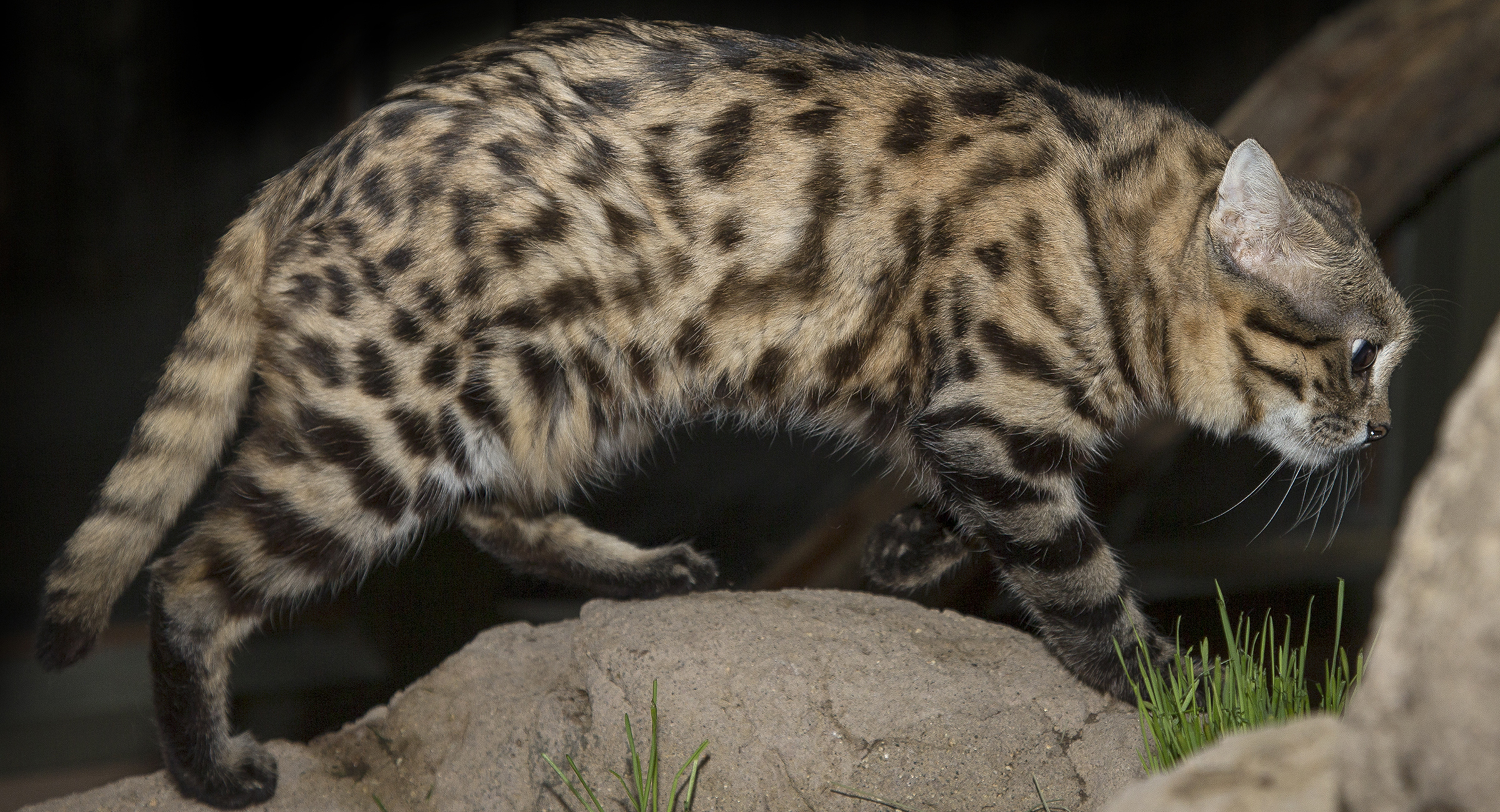
Did You Call Me “Small”?
Making their home in dry, open grasslands, black-footed cats are found in only three countries in Africa—Botswana, Namibia, and South Africa. Their soft, dense coat ranges from reddish-brown to golden tan, with round, dark spots that expand to rings or bands on their legs, neck, and tail. The hair on the undersides of their front paws and back legs is black, hence the name “black-footed.” This patterned coat helps with camouflage, which comes in handy whether you’re predator or prey!
Standing less than 10 inches at the shoulder, this feline is no scaredy-cat. Despite being the smallest cat in Africa and one of the smallest cat species in the world, the black-footed cat has a big reputation. Local folklore depicts the three- to six-pound felines as possessing both the “personality of a tiger” and the ability to “rip the jugular out of a giraffe.” That may be a bit exaggerated, but there’s no overstating that this small cat is a big-time hunter. Males have been known to bag prey twice their size, including Cape hares and black bustards. Black-footed cats are opportunistic carnivores, meaning they dine on whatever they can catch and overpower. Common food sources include rodents and other small mammals, reptiles, insects, and birds. And with a hunting success rate gauged at 60 percent, a lot of hunting skill is packed into that small feline body: some reports list a single black-footed cat’s annual rodent intake at 3,000! And when pursuing a tasty moving morsel, black-footed cats choose between three hunting styles they have up their spotted sleeves: “fast-hunt,” in which the cat moves in swift bounds to flush prey from cover; “slow-hunt,” involving a slow, stalking pace; and “sit-hunt,” where the animal waits patiently for its prey at a rodent den for up to two hours.
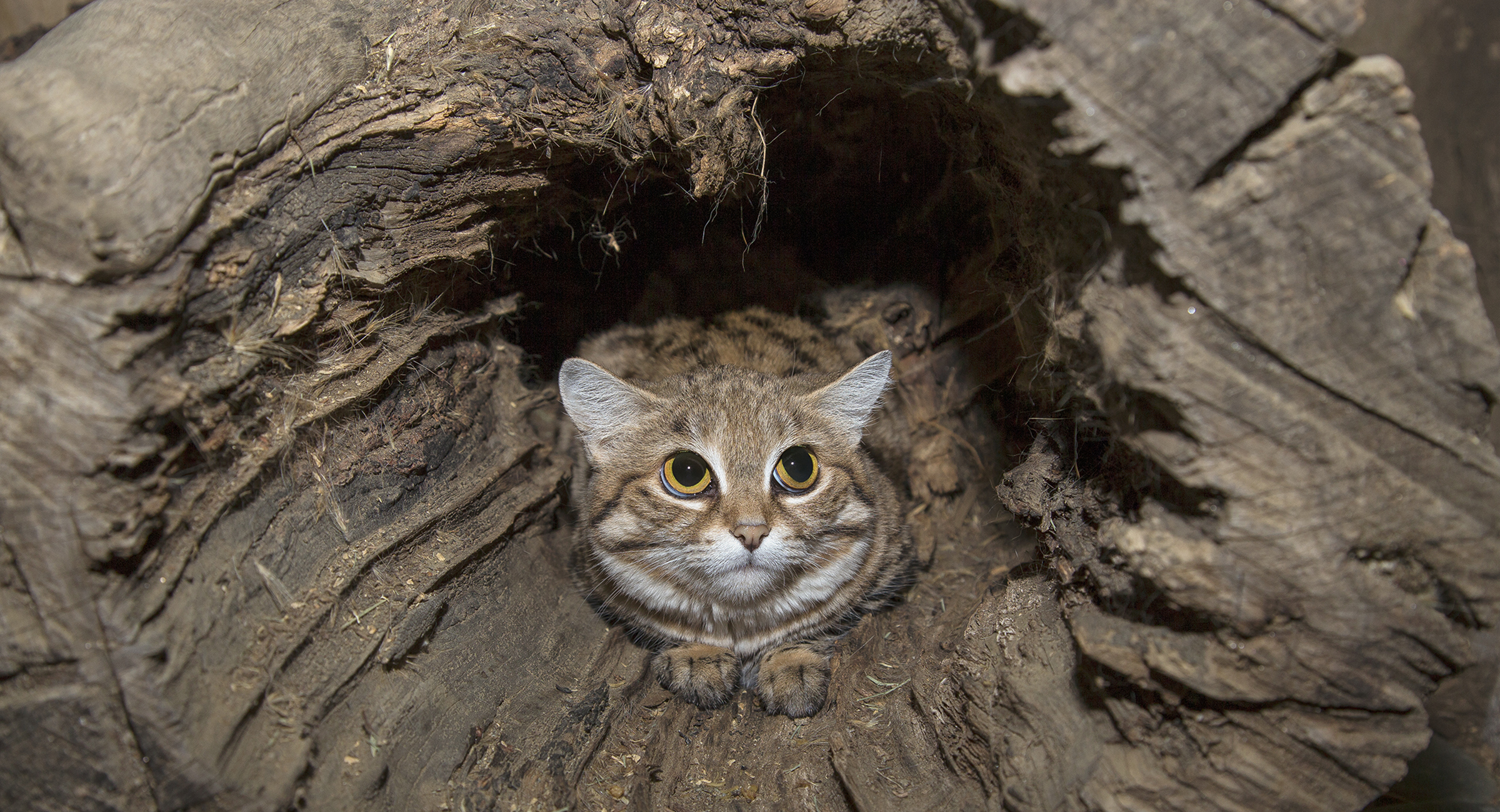
Enigmatic Nomads
Nocturnal and solitary, black-footed cats are rarely observed in the wild. The Black-footed Cat Working Group is the only group to ever conduct long-standing field studies of this elusive species, notes Nadine Lamberski, San Diego Zoo Global Corporate Director of Animal Health, DVM, DACZM, DECZM, who serves as veterinary advisor for the group. During the day, they rest in hideouts, such as the abandoned burrows of other animals like springhares, porcupines, and aardvarks. Their willingness to sublet hollowed-out termite mounds, if the need arises, likely led to their Afrikaans common name, miershooptier, which means “anthill tiger.” Black-footed cats move around quite a bit, following food sources and avoiding predators such as wild dogs, jackals, and caracals. Within a year, males inhabit a range of about 8.5 miles, and females inhabit about 4; although recent research indicates their home ranges may be much larger. Keepers are well aware of this species’ housing habits, and when both cats are living in the exhibit at the Park’s Ione and Paul Harter Animal Care Center in Nairobi Village, Yuna and Sawyer have a number of den options. “They have a few den choices, and Yuna likes to perch up high,” Autumn says. “In the wild, these cats—especially females with kittens—move locations to keep the babies safe, so we let them choose.” Like their brethren in the wild, Yuna and Sawyer spend much of the day tucked into a cozy spot. “They’ll rest together. Their active times are early in the morning and in the evening.”
One decidedly uncatlike characteristic is the black-footed cat’s relatively poor climbing ability. Their stocky build and shortish tails don’t help with balance, so these felines would rather keep their tootsies on terra firma. But even this rule has its exceptions. “Yuna likes to climb up, crouch on her log, and survey her surroundings,” Autumn says.
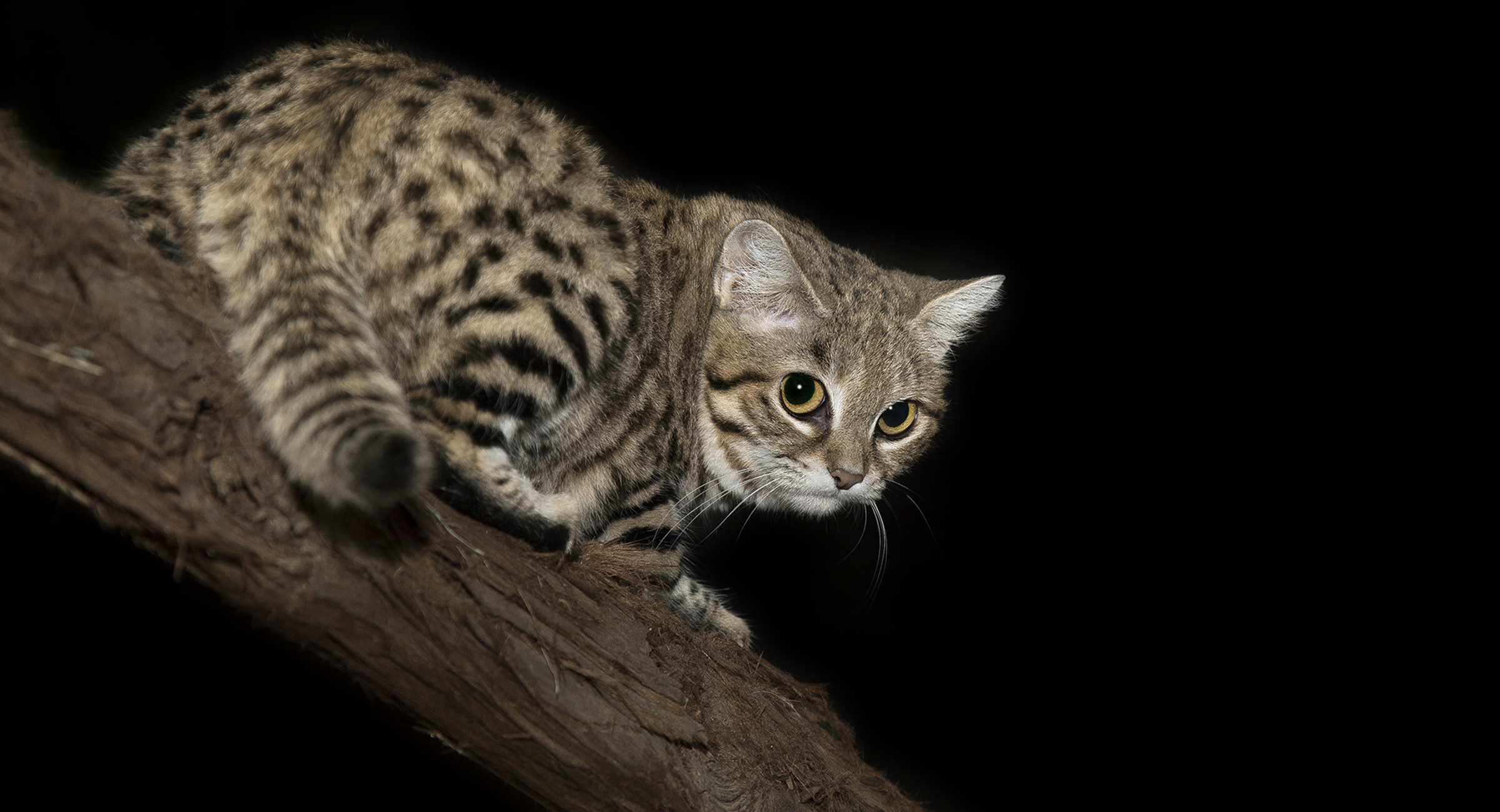
A “Furry Tail” Romance
The black-footed cat’s feisty “cattitude” is part of the animal’s charm, and the Park’s cats are no exception. “Yuna has always had a big personality, but she has mellowed a bit,” Autumn says. “She enjoys ‘talking” (chattering) to us, but we keep in mind she’s still wild.” Something—or someone—else that keepers hoped Yuna would be “wild” about was Sawyer, the handsome male introduced to her in May 2017. Introductions were made gradually, until it looked pretty certain that the pair would get along. Autumn says that for a wild cat, Sawyer is mellow, but is definitely confident, greeting keepers at the door. “He’s right there, especially if he thinks there’s food!” she says.
Autumn and the other keepers make sure that food isn’t the only thing the cats have to look forward to. “We want their lives to be as stress-free and enriching as possible, noting that a little variety helps keep the exhibit enriching. “Sometimes even just changing the substrate the cats walk on—adding mulch or sand—makes things new all over again.” she says. “We hide meat for them to find, play recordings of different sounds, add new scents, conduct play sessions. We keep things interesting. And does it work? “The feather-on-a-string chase game is popular with both cats,” Autumn says.
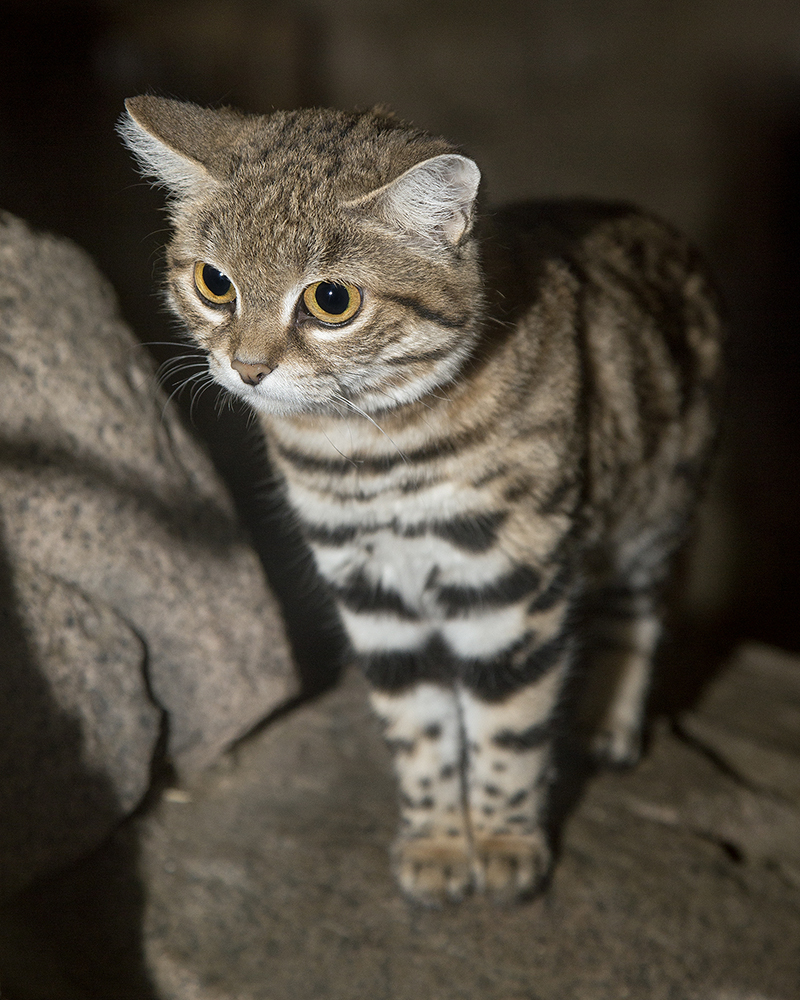
THE “EYES” HAVE IT
The black-footed cats’ large eyes have a mirror-like layer behind the retina, the tapetum lucidum, which reflects light at night.
Challenges ranging from habitat destruction to trapping and bait poisoning leave the black-footed cat’s population in a vulnerable status. “We are committed to helping the black-footed cat’s SSP and strengthening their numbers here and in the wild,” Autumn says. Nadine agrees. “Improved understanding of the distribution, habitat use, reproduction, and health of black-footed cats aids in identifying threats to these fragile populations,” she explains. “Outreach and education efforts are aimed at reducing the intentional persecution of black-footed cats. Strong small cat populations contribute to the biodiversity of healthy ecosystems.” Given the species’ status, every kitten is a new hope for the future. And while Yuna and Sawyer have bred, keepers have yet to hear the pitter-patter of little paws. But just in case, Autumn says, husbandry practices are in place to give the cats the best chance for success. “We test Yuna’s feces for progesterone levels to watch for a pregnancy,” she says. “We also weigh her weekly, which is another good way to watch for it.” Both cats cooperate during health care procedures, something Autumn attributes to positive interactions with keepers. “They are target trained and willingly step onto a scale,” she explains. “We’ll even be able to get radiographs of her kittens if she gets pregnant.”
The relationship that keepers have fostered with Yuna and Sawyer has resulted in what Autumn believes to be an atmosphere of respect and trust. “We can go into the exhibit with them, and they are not stressed,” she says. “They are not pets and we don’t want them to be. They are perfect, hissy little cats. Just like they should be.” Autumn hopes the next chapter of Yuna and Sawyer’s story will involve offspring. “These would be our first-ever black-footed cat kittens,” she says. “And we’re ready!”

